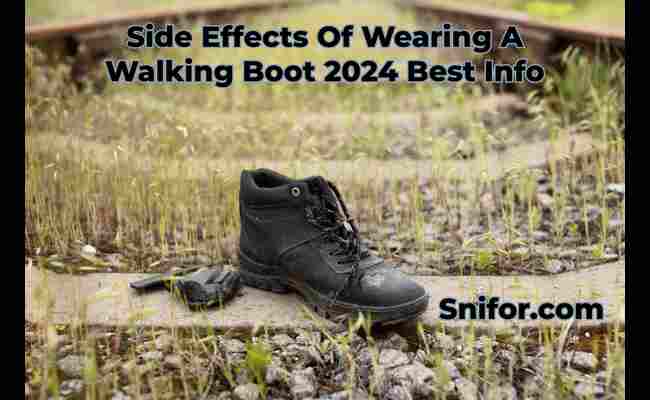
Is Marching Band A Sport 2024 Best Info About Marching Band
January 27, 2024
Can A Chiropractor Help With Sciatica Pain 2024 Best Info
January 27, 2024Understanding the Side Effects of Wearing a Walking Boot
Today’s topic is Side Effects Of Wearing A Walking Boot 2024 Best Info. Wearing a walking boot, also known as a cam walker or orthopedic boot, is often necessary to facilitate the healing process of foot or ankle injuries. However, it’s crucial to be aware of the potential side effects associated with its use. This comprehensive guide discusses the common side effects of wearing a walking boot, how to manage discomfort and complications, and the steps to prevent potential long-term consequences.

Side Effects Of Wearing A Walking Boot
What is a Walking Boot and When is it Worn?
A walking boot is a type of medical footwear designed to immobilize the foot and ankle, providing stability and support during the recovery period. It is typically worn to aid in the healing of various lower leg injuries, such as a sprained ankle or foot, controlled ankle movement, or joint pain associated with controlled ankle movement.
Also Read: What Is The Average Weight For A 14 Year Old
Explanation of a Walking Boot
The walking boot, also referred to as a cam boot or controlled ankle motion (CAM) boot, is constructed with a supportive sole and a tall, plastic shell that encases the lower leg. The boot is specifically engineered to restrict ankle movement and offer protection to the injured foot or ankle.
When is the Walking Boot Worn?
A walking boot is worn when a patient experiences a foot or ankle injury that requires immobilization to prevent further damage and promote healing. Common instances include sprains, fractures, or post-surgery recovery.
How Long Should a Walking Boot be Worn?
Patients may need to wear a walking boot for a duration of up to 6 weeks, depending on the severity of the injury and the recommended treatment plan by their healthcare provider. It’s essential to adhere to the prescribed wearing period to ensure proper healing and recovery.
Also Read: How Long Does A Cpr Certification Last
Common Side Effects of Wearing a Walking Boot
While a walking boot is beneficial for supporting the healing process, there are potential side effects that individuals may experience during its use. These include pain and discomfort, restricted ankle movement, and an increased risk of developing blood clots.
Pain and Discomfort
Pain with controlled ankle movement or associated joint pain with controlled ankle movement may arise during the use of the walking boot. Patients should communicate any discomfort with the boot to their healthcare provider for appropriate adjustments.
Restricted Ankle Movement
The design of the walking boot restricts the natural range of motion of the ankle, which can lead to feelings of confinement and limited mobility. It’s important to follow specific exercises and movements recommended by the healthcare provider to prevent stiffness and improve flexibility once the boot is removed.
Possible Development of Blood Clots
Prolonged immobilization of the lower leg, such as when wearing a walking boot, may increase the risk of developing blood clots. Patients should be vigilant for symptoms such as swelling, pain, or redness in the lower leg and seek medical attention if any concerning signs arise.
Managing Discomfort and Complications
To alleviate discomfort and minimize potential complications associated with wearing a walking boot, several strategies can be employed, including the use of crutches alongside the boot, minimizing the risk of blood clots, and addressing immobilization-related issues.
Also Read: How Much Does A Breast Reduction Cost
Using Crutches Alongside the Boot
Patients may benefit from using crutches to offload weight from the injured foot or ankle while wearing the boot, reducing the impact on the affected area and promoting a more comfortable mobility experience during the recovery period.
Minimizing the Risk of Blood Clots
Staying active within the recommended limits and performing specific exercises provided by the healthcare provider can help minimize the risk of blood clot formation. Additionally, proper foot and leg elevation and regular movement of the toes can aid in preventing this potential complication.
How to Deal with Immobilization-Related Issues
Patients should pay attention to any signs of skin irritation, especially at the edge of the boot. Keeping the boot dry and ensuring proper positioning can help reduce skin-related discomfort. Moreover, individuals with a history of chronic pain or mobility issues should discuss the use of the walking boot with their healthcare provider to mitigate potential secondary pain.
Avoiding Prolonged Usage and Facilitating Recovery
To prevent potential long-term consequences and expedite recovery, careful attention should be given to foot and ankle health, ensuring proper fit and positioning of the boot, and initiating rehabilitation and physical therapy after the boot’s removal.
Also Read: How To Get Rid Of A Canker Sore In 24 Hours
Impact on Foot and Ankle Health
Prolonged usage of a walking boot can impact foot and ankle health, potentially leading to muscle atrophy or decreased strength. Hence, transitioning out of the boot at the appropriate time and engaging in recommended exercises can aid in restoring normal function and strength to the affected area.
Ensuring Proper Fit and Positioning of the Boot
Patients must ensure that the walking boot fits snugly and is positioned correctly to provide optimal support and immobilization. Any discomfort or pressure points should be promptly addressed to prevent skin irritation and discomfort.
Rehabilitation and Physical Therapy After Boot Removal
Participating in rehabilitation and physical therapy sessions post-boot removal is crucial to regain muscle strength, mobility, and flexibility in the foot and ankle. These sessions play a vital role in facilitating a smooth transition back to regular activities and minimizing any long-term effects of using the walking boot.
Preventing Potential Long-Term Consequences
Moreover, understanding the risks of prolonged immobilization, returning to normal activities post-walking boot, and assessing the likelihood of reoccurrence or continued ankle issues are essential in preventing potential long-term consequences.
Understanding the Risks of Prolonged Immobilization
Prolonged immobilization, such as extended use of a walking boot, can lead to muscle weakness, stiffness, and reduced joint flexibility. Patients should follow the guidance of their healthcare provider to gradually reintroduce movement and weight-bearing activities for a successful recovery.
Return to Normal Activity Post-Walking Boot
After the removal of the walking boot, individuals should gradually resume normal activities and exercises, ensuring careful monitoring of any discomfort or signs of reinjury. A gradual return to regular activities is vital to prevent overexertion and facilitate full recovery.
Gauging the Likelihood of Reoccurrence or Continued Ankle Issues
Patients should work closely with their healthcare providers to assess the likelihood of reoccurrence or persistence of ankle issues following the use of a walking boot. Addressing any ongoing concerns and adhering to recommended preventative measures can aid in minimizing the risk of future complications.
Also Read: How To Heal A Torn Meniscus Naturally
Q: What are the common side effects of wearing a walking boot?
A: Common side effects of wearing a walking boot may include lower back pain, hip pain, discomfort in the ankle and foot, and potential pain in secondary sites such as the lower extremities.
Q: How long should I wear a cam walker boot?
A: The duration of wearing a cam walker boot varies based on the severity of the condition. It is typically recommended to wear the boot for at least a few weeks to a few months, and then gradually transition out of it as per your healthcare provider’s instructions.
Q: Can wearing a walking boot cause lower back or lower extremity pain?
A: Yes, in some cases, wearing a walking boot may lead to lower back or lower extremity pain, especially during the initiation or cessation of boot wear. It is important to communicate any discomfort to your healthcare provider.
Q: How can I minimize the risk of side effects while wearing a cam walker boot?
A: To minimize the risk of side effects, it’s important to follow the guidelines provided by your healthcare provider. This may include keeping your boot dry, taking regular breaks from wearing the boot, and engaging in recommended exercises to alleviate discomfort.
Q: What should I do if I experience hip or lower back pain while wearing a walking boot?
A: If you experience hip or lower back pain while wearing a walking boot, it is advisable to consult with your healthcare provider. They can assess the source of the discomfort and provide guidance on how to manage it effectively.
Q: Are there any potential long-term effects of wearing a cam walker boot?
A: Prolonged use of a cam walker boot may lead to issues such as muscle atrophy, stiffness, or secondary site pain months after cessation of boot wear. It’s important to adhere to the recommended duration and gradually transition out of the boot under medical supervision.
Q: What can I expect in terms of pain 3 months after cessation of boot wear?
A: Some individuals may experience residual pain 3 months after discontinuing the use of a walking boot. This pain may manifest in the affected foot or ankle, as well as in secondary sites such as the lower back or lower extremities.
Q: Should I put the boot back on if I experience discomfort after ceasing to wear it?
A: If you encounter discomfort or pain after discontinuing the use of the walking boot, it’s important to consult with your healthcare provider. They can evaluate the situation and provide appropriate guidance, including whether reapplying the boot may be necessary.
Q: Can wearing a cam walker boot impact my daily activities and mobility?
A: While wearing a cam walker boot, your mobility and daily activities may be impacted to some extent. It is important to follow your healthcare provider’s recommendations and modify activities as necessary to ensure proper healing and minimize potential discomfort.
Q: What are some potential measures to alleviate discomfort associated with wearing a walking boot?
A: To alleviate discomfort while wearing a walking boot, you can engage in recommended exercises, adhere to proper boot wear guidelines, and communicate any issues to your healthcare provider. They can provide additional suggestions or interventions to help manage any discomfort effectively.
Hope you enjoy reading our article Side Effects Of Wearing A Walking Boot 2024 Best Info.



